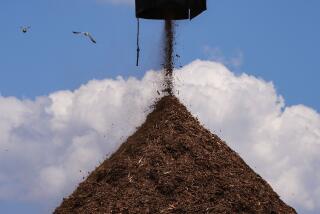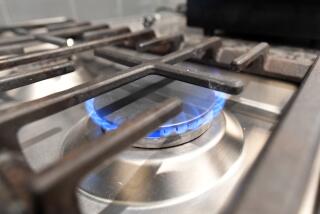Home Improvement : Pellet Stoves Are Clean, Use a Renewable Fuel
- Share via
QUESTION: I have heard a lot about the very energy-efficient and environmentally clean pellet stoves for heating a house. How do they work and are they suitable for the mild Southern California climate?
ANSWER: Pellet stoves are one of the most exciting recent innovations in home heating. In addition to being very energy-efficient and convenient to operate, they use a renewable fuel source: waste wood from lumber mills. They also burn cleanly with relatively low emissions.
The heat output from a pellet stove is adjustable up to a maximum of only 30,000 BTU per hour. This makes it ideal for a mild climate. One manufacturer even offers a model with a furniture-quality wood cabinet and 24-karat gold-plated doors. It makes an attractive addition to your room year-round.
High-energy pellets are made by compressing waste wood scraps at a lumber mill. These pellets are sold in 40-pound bags. With low moisture content and high-temperature combustion of the pellets, very little pollution is produced. Also, only 1% remains as ash in the pellet stove.
Since pellet stoves are extremely energy-efficient, you don’t need a chimney. The exhaust gases are forced outdoors (by a fan) through a small flexible stainless pipe through the wall. The inlet combustion air is also drawn in from outdoors, so none of your heated room air is wasted.
A pellet storage hopper is built into the back of the stove. You just pour a bag of pellets into the hopper. A special auger automatically feeds in the pellets at the proper rate to provide as much heat as you want. You can add a computerized room thermostat to control the burn rate.
The computerized electronic controls on these stoves are very sophisticated, like those on modern gas furnaces. Depending on pellet size and type of wood, you make the initial auger speed setting. Then you have several heat ranges that you can manually set or have thermostatically-controlled.
Your room air is circulated through and heated in the heat exchanger by a multispeed blower. Once you start the fire and adjust it, you just fill the hopper with a bag of pellets each day and forget about it.
The combustion air is forced by a fan to circulate around the small burning pellets, so they burn very completely. You can get from 20 to 30 hours of heat from each bag of pellets you pour into the hopper.
You can write to me for Utility Bills Update No. 129 showing a list of manufacturers of pellet stoves, operating cost comparison with gas, oil and electric furnaces, and information on the wood cabinet model. Please include $1 and a self-addressed business-sized envelope. Send your requests to James Dulley, c/o Los Angeles Times, 6906 Royalgreen Drive, Cincinnati, Ohio 45244.
Pressure Cooker Can Save on Energy Use
Q: Does it really save any energy to use a pressure cooker instead of a regular pot on my stove?
A: Using a pressure cooker can save energy because it cooks foods much faster. Since less total heat is given off into your house, the savings is greatest in the summer when you are air conditioning.
Pressure cookers can cook faster because the temperature of the food and water in the cooker gets hotter than the normal boiling point of water. Always follow the user instructions, especially when opening the hot cooker.
More to Read
Inside the business of entertainment
The Wide Shot brings you news, analysis and insights on everything from streaming wars to production — and what it all means for the future.
You may occasionally receive promotional content from the Los Angeles Times.










